
- © 2025 Pride Publishing Inc.
All Rights Reserved
In his speeches and writings, James Baldwin describes a bleak, lonely, hungry exile in which he and all American blacks, whatever their station and fortune, go from dawn to dusk in constant terror. His early exile began in Harlem's streets, which he later said were filled with "beautiful black people" despoiled by the pressure of the white world.
Author James Baldwin (right) and Bayard Rustin, deputy director of the March on Washington, discuss civil rights incidents in Alabama during a news conference in New York. The two civil rights leaders called on President John F. Kennedy to use troops to "break the hold" of Gov. George Wallace, saying that otherwise "there will be rioting in Alabama" that will affect the entire nation. The armband displayed was to be worn at a rally scheduled in New York on September 22, 1963, "to protest the brutal murder of Negro children in Birmingham."
Civil rights leaders clasp hands as they sing during the closing of memorial ceremonies in New York, September 22, 1963, for four girls killed in the bombing of the Birmingham, Ala., Sixteenth Street Baptist Church. From right are author James Baldwin; James Farmer, president of the Congress of Racial Equality; unidentified man; and veteran Socialist leader Norman Thomas. At a rally on Foley Square, Farmer charged the U.S. Department of Justice and President Kennedy with a share of the blame in the September 15 bombing, and Thomas said he was "ashamed that I was a white American, when the bombing took place."
A group of American musicians in Paris threw their spiritual weight behind the upcoming civil rights demonstration scheduled for August 28, 1963, in Washington during a meeting with author James Baldwin in a downtown Paris club, August 18, 1963. Baldwin is congratulated by actor Anthony Quinn following a speech at an American church.
A group of black American jazz musicians and others listen to author and activist James Baldwin as he presented civil rights groups' views after the sermon at the American Protestant church in Paris, August 1963. The musicians threw their spiritual weight behind the upcoming civil rights demonstration in Washington, D.C.
Gov. Pat Brown of California (current Gov. Jerry Brown's father) and writer James Baldwin agreed that racial segregation is "like a creeping disease," May 9, 1963. Brown told Baldwin, on a western speaking tour, he would like to make California "the symbol of what all states should do" about segregation. "All the governor can do is set an example," Brown said, "and I think I've done that."
Baldwin poses in front of his typewriter in his house, March 15, 1983, Saint Paul de Vence, France.
From left: film director Joseph Mankiewicz, actor Charlton Heston, and James Baldwin after their arrival at National Airport in Washington, August 27, 1963. They would then participate in the August 28 March on Washington for Jobs and Freedom.
Actor Marlon Brando poses with his arm around James Baldwin in front of the Lincoln statue at the Lincoln Memorial, August 28, 1963, during the March on Washington demonstration ceremonies, which followed the mass parade. Posing with them are actors Charlton Heston (left) and Harry Belafonte.
Ray Charles is shown performing at Carnegie Hall in New York July 1, 1973. James Baldwin, narrator of the show, sits on a stool at the opposite end of the piano at right.
American novelist James Baldwin and composer and conductor Leonard Bernstein pose together shortly after they were awarded the French Legion d'Honneur by French President Mitterrand at the Elysees Palace in Paris, June 19, 1986.
Baldwin, author of the Broadway play Blues for Mr. Charlie, and director Burgess Meredith raise champagne glasses in a toast to Diana Sands, one of the play's stars, at party following the opening at the A.N.T.A. Theater, April 23, 1964, in New York. The play, which deals with racial problems, is dedicated to slain civil rights leader Medgar Evers and "the dead children of Birmingham."
Novelist and playwright James Baldwin arrives from Paris aboard a TWA Starstream jet, November 9, 1965. In Europe since August, he has spent the past few weeks touring the major cities of the continent with his stage play The Amen Corner, which was sponsored by the State Department.
See more about John Jennings here.
Baldwin, at 45, alive and well in Istanbul, Decenber 19, 1969, and planning to return to the U.S. Baldwin feels that "in some ways" he is the last unassassinated black leader of his generation, but he has not withdrawn from the civil rights struggle or lost hope for the future.
Baldwin chats with Myrlie Evers, widow of civil rights activist Medgar Evers, after they attended a screening of the film For Us, the Living: The Medgar Evers Story, in New York, March 3, 1983.
Baldwin, seen in New York June 19, 1963, once wrote, "I am a very tight, tense, lean, abnormally ambitious, abnormally intelligent, and hungry black cat. I am not a nigger, I'm a man." The 38-year-old writer has raised his voice to protest that to the white man all black men are nameless and menial.
Author James Baldwin addresses a CORE meeting in Los Angeles, June 19, 1963. After his talk, he said in an interview, "I am not a spokesman for anyone. I speak only for myself. I never intended to be a Negro spokesman."
Baldwin visits Marlon Brando (left) and Charles Chaplin on the set of A Countess From Hong Kong at Pinewood Studios in London, March 1966. Baldwin made a special trip from New York to submit to Brando a film treatment on his play Blues for Mr. Charlie, which he plans to put on the soundstages in the fall. Baldwin reports he is also completing his fourth novel, Tell Me How Long the Train's Been Gone.
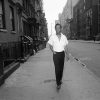
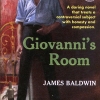
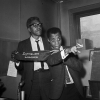
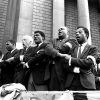
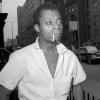
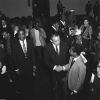
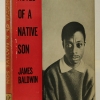
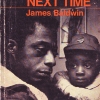
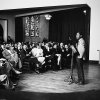
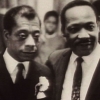
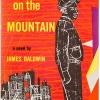
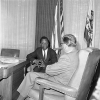
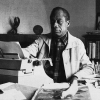
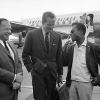
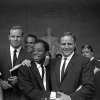
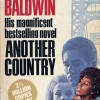
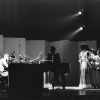
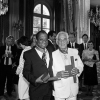
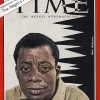
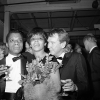
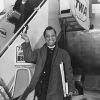
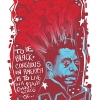
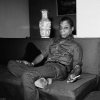

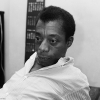
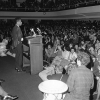
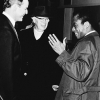
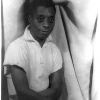
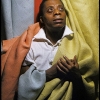
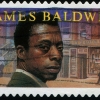
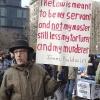
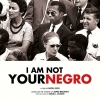
READER COMMENTS (